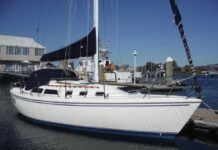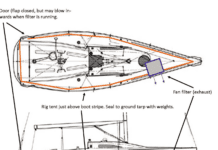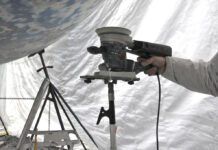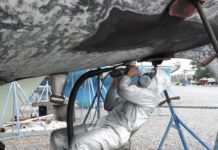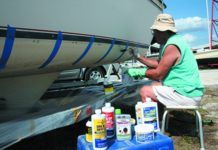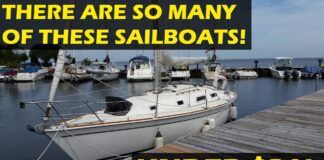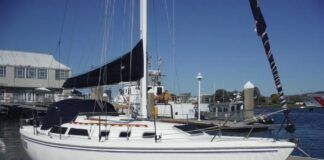Techni-Ice
As a longtime subscriber to Practical Sailor, I have rarely found much reported information that I would disagree with. Also, my wife and I normally do not get “taken in” at boat shows with products that appear to be better than they really are. Techni-Ice however is one of these products. We did find the product worked well for keeping things cold, but its water- absorbing property to me makes it very limited in usage.
What we found was that any food product that contained fluid (frozen hamburger beginning to thaw out, as an example) would be readily absorbed by the Techni-Ice and would therefore become unusable.
We still use “blue ice” packsand our frozen hamburger does not thaw out, and if it did at leastthe “blue ice” can be cleaned off and reused.
-R. Wayne Habermehl
Lafayette Hill, PA
You make a good point about absorption. We too found that Techni-Ice wouldn’t serve every need-we still think real ice is necessary. But we would still choose Techni-Ice over blue ice packs, taking care to seal all cooler contents-including ice- against leakage.This from Techni-Ice:
Your customer is right; we specifically state in all our instructions not to mix T-Ice with ice or other liquids. It will hydrate that liquid into the cells. Over-hydration can split the outer layer when freezing.
-Peter Welshofer
BSSI/Techni-Ice Division
www.techniice.com
———-
Dead Reckoning
Your editorial on dead reckoning makes the same points that we make in our seminars on celestial navigation. Compasses and sextants have been, shall we say, “under-appreciated” by some mariners since the Age of GPS. Good for Practical Sailor for featuring steering compasses (August) and sextants (April). Let’s hope that sailors continue to hold traditional navigation methods in the same high esteem that they hold their traditional vessels.
-Ken Gebhart
Celestaire, Inc.
———-
The Wrong Leak
I just read your response to Jean Beaudreault regarding the water accumulating in his Zodiac (PS Advisor, August 1). I believe you may have misinterpreted the problem. It sounds as though the leak is in the floor attachment and not the air chambers. I would try drying the underside of the dinghy thoroughly, suspend it off the ground and put a few inches of water inside while checking for water seeping underneath. Just be careful to make sure that the method used to support the Zodiac can withstand the additional weight of the water.
-David Fisichella
Woods Hole, MA
You’re right- we jumped to the wrong diagnosis. Mr. Beaudreault, our apologies-please follow Mr. Fisichella’s advice (unless ours happened to work). Thanks, too, to Harlan Holmes of Marina Del Rey, CA, and Luther Abel, who sent similar letters.
———-
Columbia 9.6 – Kettenburg 32
I was pleased to see the article on the Columbia 9.6 (August 1). I own a Kettenburg 32, which is the Columbia 9.6 hull as completed by Kettenburg, a California boatbuilder which had yards in Channel Islands and San Diego. It is my understanding that Kettenburg purchased the 9.6 hulls from Columbia when it ceased production of wooden sailboats.There are a number of wooden Kettenburg sailboats in the 30- and 40- foot range still to be found in California. They are classics and quite pretty.
The Kettenburg version has a slightly different interior layout and,like the 9.6, is all teak down below. The only exposed fiberglass below isthe sole in the head.
This boat definitely feels like a “woody” down below. I have been very impressed by the quality and strength of the construction. For example, the cockpit sole is a full inch or more of plywood/glass laminate! All the bulkheads are glassed to the floors, hull, and deck. I’ve added a lot of cruising gear, so have drilled plenty of holes in the deck, coamings, etc. and am always amazed at how thick the laminate is.
I would share the observations made by many in your survey,especially with regard to the underpowered standard Volvo Penta engine. Mine still only has 1,200 hours on it after 21 years of use and will probably outlive me, but it will only push the boat at 5 knots in relatively calm water, less with any head seas.
I also agree with the majority view that the boat is a little hard to balance when sailing off the wind. When you do get it “in the groove” it is a pleasure to sail.I believe the skeg betweenthe keel and rudder really helps the boat track, especially when beating.
I don’t race, so I have no concern with ratings, etc. I routinely make crossings of the Santa Barbara Channel at 6+ knots, which is all I thinkyou can expect from a 32-foot boat with a waterline of less than 24 feet.
Keep up the great work.
-David C. Turpin
Santa Barbara, CA
———-
You reviewed my model! Or at least close to it. I have a Kettenburg 32- same as a Columbia 9.6. In fact there was a K 9.6 marketed-“K” for Kettenburg’s part. The major difference is the interior layout (still lots and lots of teak). All LOA, LWL, beam, etc., numbers are the same.
Your observations on the 9.6 gave me the insight that you folks do a very good job at sizing up a boat, as all of your conclusions matched mine after three years of ownership. The one area that was not in line with my experience was the complaint that “she will not race to her rating…” as stated by owners. I race quite a bit and did OK until I got a new main with a maximum allowable roach and a Kevlar racing genoa. It greatly improved light-air performance and took almost all of the weather helm out when going hard to windward. I win a good share on corrected time and beat about half the J-24 fleet (with a PHRF rating around 174)!
I repowered with a new Yanmar 3-cylinder (little or no changes to exhaust, and all linkages). The stringers that attach the motor mounts needed to be built up and stepped at the rear. It is more power than I need at 27 hp, but after the Volvo I wanted to be sure.
Thanks for all your great articles!
-Scott Dempster
Ventura, CA
———-
No Place Like Home
As one who has purchased a couple of sets of your used-boat review volumes, I gladly admit that I rely on PS for learning about used boat models that are in my sights and my price range. So please take this as a minor quibble. It regards your suggestion (July 1) that a prospective used boat buyer consult the big, slick magazines There are never more than a handful of honest-to-goodness private party classifieds in those magazines. The price of advertising in those magazines is prohibitive. And, besides, what private seller wants to field inquiries from tire kickers nationwide?
Your suggestion about Soundings is excellent. But you seem to give short shrift to the regionals. My own experience (and I must confess that Im a partner in one of the regionals) is that magazines like 48 North, Latitude 38, Santana, Southwinds, SpinSheet and Points East (my publication) offer the best indications of pricing and selection in the geographic area that the prospective buyer or seller is in. Someone inAnnapolis isn’t interested in what a Catalina 30 costs in Massachusetts; he or she wants to know the range of prices for that model is in the Chesapeake Bay area. Therefore, the place to do research is in the regional that serves the Chesapeake Bay area, i.e. SpinSheet.
-Bernie Wideman
Points East Magazine, Portland, ME
———-
Faraday vs. Murphy
Bob Gillette’s idea for a Murphy Bag to guarantee some minimal navigational ability after a lightning strike (putting a spare GPS, hand-bearing compass, handheld VHF and batteries into a hermetically sealed and foil-wrapped bag) is an excellent one. Your reply, blowing off the idea of foil-wrapping and suggesting a hot water bottle might be of as much help, clearly wasn’t written by one of your electronics-savvy staff. While lightning is tricky stuff it generally likes to stay on the exterior surface of conductive materials; the foil wrap should provide excellent protection.
If you want to see a spectacular example of the “foil wrapping” idea, journey up to Boston sometime and go to their Museum of Science.In it they have an artificial lightning generator which can throw 100-foot bolts. The operator sits right in the middle of the floor, protected by nothing more than the giant metal birdcage he sits in.
-Luther Abel
Via e-mail
———-
I read Mr. Gillette’s letter (PS Advisor, August 1) about protecting electronic devices from lightning strikes by wrapping them in aluminum foil with great interest. He’s on the right track, but only part way to the protection he’s trying for.
The modern composite military ships I’ve worked on are all hardenedagainst both EMI-RFI (electromagnetic and radio frequency interference)and EMP, the electro-magnetic pulse that occurs when a nuclear device isdetonated. (In the ’40s the EMP from a nuclear blast in Micronesiacaused power outages in Hawaii.) On these ships, each electrical device and critical ship’s compartment is an isolated “Faraday Cage”-a completely EMI-RFI sealed container that’s grounded. This may sound simple, but it’s actually rather complex. As it’s been described to me by an EMI specialist, “If water or air can leak in or out, so can EMI-RFI-EMP.”
Each protected compartment in a composite ship is lined with heavygauge copper screen, and each and every hatch or door has both rubbergaskets-for isolation from CBN (chemical, biological, nuclear) contaminants -and an elaborate system of interlocking bladed metal “gaskets” that establish an EMI-RFI-EMP ‘seal’ across the non-conductive rubber gasketed opening. Windows have embedded conductive mesh or conductive coatings. Electronics are in heavy gauge metal cases, with conductive screening across any openings, with the whole system grounded to massive equivalents of the sintered bronze “DynaPlates” familiar to boaters.
A “Murphy Box” or Faraday Cage to protect electronics would requireheavier metal than aluminum foil, which would probably simply vaporize under the huge current surge of a lightning strike. Heavy gauge grounding wires running to a big grounding plate below the waterline would also be required. The Thomas Register lists EMI-RFI gasketing products if Mr. Gillette is interested in pursuing his concept further.
-Bruce Pfund
Westerly, RI
———-
You guys can work on Faraday Cages if you want. If we were worried enough we’d still go with an insulator, not a conductor: 1. Cut top off rubber hot water bottle. 2. Put in back-up gizmos. 3. Seal carefully. 4. Cross fingers. 5. Move to next worry.
I have a Navico Wheelpilot 300CX installed on my Flying Dutchman 37 and have been very satisfied with it, until now. Its drive belt recently broke and I called Simrad in Lynnwood to order a new one plus a spare. The saleslady said it was $60 but that since it was a “belt pack” it probably had two belts included.
I just received the package and it did indeed have two belts, a large drive belt (the one that broke) and a small drive belt that transfers power from the drive motor to an intermediate gear. When I called Simrad to complain about what I feel is a ridiculous price they just said, “Yes, the Navico parts are pretty expensive.”
-Dwayne Speer
Richland, Washington


